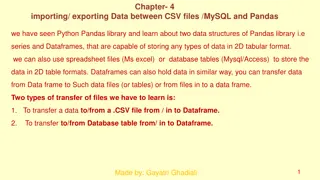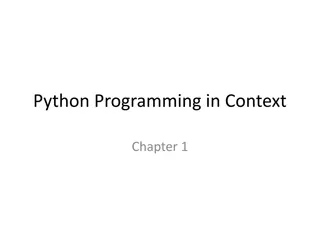
Data Handling Using Pandas: Comprehensive Python Libraries
"Learn about Pandas, a powerful Python library for data handling and analysis. Explore its features, installation steps, and benefits in data science. Discover how to use Matplotlib for visualization."
Download Presentation

Please find below an Image/Link to download the presentation.
The content on the website is provided AS IS for your information and personal use only. It may not be sold, licensed, or shared on other websites without obtaining consent from the author. If you encounter any issues during the download, it is possible that the publisher has removed the file from their server.
You are allowed to download the files provided on this website for personal or commercial use, subject to the condition that they are used lawfully. All files are the property of their respective owners.
The content on the website is provided AS IS for your information and personal use only. It may not be sold, licensed, or shared on other websites without obtaining consent from the author.
E N D
Presentation Transcript
Informatics Practices Class XII Chapter1 Data Handling using Pandas -1
Data Handling using Pandas-1 Python Library Matplotlib Matplotlib is a comprehensive library for creating static, animated, and interactive visualizations in Python.It is used to create 1. Develop publication quality plots with just a few lines ofcode 2. Use interactive figures that can zoom, pan,update... We can customize and Take full control of line styles, fontproperties, axes properties... as well as export and embed to a number of file formats and interactive environments
Data Handling using Pandas-1 Python Library Pandas It is a most famous Python package for data science, which offers powerful and flexible data structures that make data analysis and manipulation easy.Pandas makes data importing and data analyzing much easier. Pandas builds on packages like NumPy and matplotlib to give us a single & convenient place for data analysis and visualizationwork.
Data Handling using Pandas-1 Basic Features of Pandas 1. Dataframe object help a lot in keeping track of our data. 2. With a pandas dataframe, we can have different data types (float, int, string, datetime, etc) all in oneplace 3. Pandas has built in functionality for like easy grouping & easy joins of data, rolling windows 4. Good IO capabilities; Easily pull data from a MySQL database directly into a data frame 5. With pandas, you can use doing regressions. 6 . T ools for loading data into in-memory different file formats. 7. Data alignment and integrated handling of missing data. 8. Reshaping and pivoting of data sets. 9. Label-based slicing, indexing and subsetting of large data sets. patsy for R-style syntax in data objects from
Data Handling using Pandas-1 Pandas Installation/Environment Setup Pandas module doesn't come bundled with Standard Python. If we install Anaconda Python package Pandas willbe installed by default. Steps for Anaconda installation &Use 1. visit the site https://www.anaconda.com/download/ 2. Download appropriate anaconda installer 3. After download install it. 4. During installation check for set path and all user 5. After installation start spyder utility of anaconda from start menu 6. Type import pandas as pd in left pane(temp.py) 7. Then run it. 8. If no error is show then it shows pandas is installed. 9. Like default temp.py we can create another .py file from new window option of file menu for new program. Visit : python.mykvs.in for regular updates
Data Handling using Pandas-1 Pandas Installation/Environment Setup Pandas installation can be done in Standard Python distribution,using following steps. 1. There must be service pack installed on our computer if we are using windows.If it is not installed then we will not be able to install pandas in existing Standard Python(which is already installed).So install it first(google it). 2. We can check it through properties option of my computer icon. 3. Now install latest version(any one above 3.4) of python.
Data Handling using Pandas-1 Pandas Installation/Environment Setup 4.Now move to script folder of python distribution in command prompt (through cmd command of windows). 5. Execute following commands in command prompt serially. >pip install numpy >pip install six >pip install pandas Wait after each command for installation Now we will be able to use pandas in standard python distribution. 6. Type import pandas as pd in python (IDLE) shell. 7. If it executed without error(it means pandas is installed on your system)
Data Handling using Pandas-1 Data Structures in Pandas Two important data structures of pandas are Series,DataFrame 1. Series Series is like a one-dimensional array like structure with homogeneous data. For example, the following series is a collection of integers. Basic feature of series are Homogeneous data Size Immutable Values of Data Mutable
Data Handling using Pandas-1 2. DataFrame DataFrame heterogeneous data. SR. No. No 1 001284 2 001285 is like a two-dimensional array with Admn StudentName Class Section Gender DateOf Birth 07/08/2010 24/02/2011 NIDHI MANDAL SOUMYADIP BHATTACHARYA SHREYAANG SHANDILYA I I A A Girl Boy 3 001286 I A Boy 29/12/2010 Basic feature of DataFrame are Heterogeneous data Size Mutable Data Mutable
Data Handling using Pandas-1 Pandas Series It is like one-dimensional array capable of holding data of any type (integer, string, float, python objects, etc.). Series can be created using constructor. Syntax :- pandas.Series( data, index, dtype, copy) Creation of Series is also possible from ndarray, dictionary, scalar value. Series can be created using 1. Array 2. Dict 3. Scalar value or constant
Data Handling using Pandas-1 Pandas Series Create an Empty Series e.g. import pandas as pseries s = pseries.Series() print(s) Output Series([], dtype: float64)
Data Handling using Pandas-1 Pandas Series Create a Series from ndarray Withoutindex e.g. With index position e.g. import pandas aspd1 import numpy asnp1 data = np1.array(['a','b','c','d']) s = pd1.Series(data) print(s) import pandas as p1 import numpy asnp1 data = np1.array(['a','b','c','d']) s = p1.Series(data,index=[100,101,102,103]) print(s) Output 100 101 102c 103d Output 1 2 3 4 dtype: object Note : default index isstarting from 0 a b a b c d dtype: object Note : index is starting from100
Data Handling using Pandas-1 Pandas Series Create a Series from dict Eg.1(without index) import pandas aspd1 import numpy asnp1 data = {'a' : 0., 'b' : 1., 'c' :2.} s = pd1.Series(data) print(s) Eg.2 (with index) import pandas aspd1 import numpy asnp1 data = {'a' : 0., 'b' : 1., 'c' :2.} s = pd1.Series(data,index=['b','c','d','a']) print(s) Output a 0.0 b 1.0 c 2.0 dtype: float64 Output b 1.0 c 2.0 d NaN a 0.0 dtype: float64
Data Handling using Pandas-1 Create a Series from Scalar e.g import pandas aspd1 import numpy as np1 s = pd1.Series(5, index=[0, 1, 2, 3]) print(s) Output 0 5 1 5 2 5 3 5 dtype: int64 Note :- here 5 is repeated for 4 times (as per no of index)
Data Handling using Pandas-1 Pandas Series Maths operations withSeries e.g. import pandas aspd1 s = pd1.Series([1,2,3]) t = pd1.Series([1,2,4]) u=s+t #addition operation print (u) u=s*t # multiplication operation 0 1 2 dtype:int64 2 4 7 print(u) output 0 1 2 dtype:int64 1 4 12
Data Handling using Pandas-1 Pandas Series Head function e.g import pandas as pd1 s = pd1.Series([1,2,3,4,5],index = ['a','b','c','d','e']) print (s.head(3)) Output a b. 2 c. 3 dtype: int64 Return first 3 elements 1
Data Handling using Pandas-1 Pandas Series tail function e.g import pandas as pd1 s = pd1.Series([1,2,3,4,5],index = ['a','b','c','d','e']) print (s.tail(3)) Output c 3 d. 4 e. 5 dtype: int64 Return last 3 elements Visit : python.mykvs.in for regular updates
Data Handling using Pandas-1 Accessing Data from Series with indexing and slicing e.g. import pandas as pd1 s = pd1.Series([1,2,3,4,5],index =['a','b','c','d','e']) print (s[0])# for 0 indexposition print (s[:3]) #for first 3 index values print (s[-3:]) # slicing for last 3 index values Output 1 a. 1 b. 2 c. 3 dtype: int64 c 3 d. 4 e. 5 dtype: int64
Data Handling using Pandas-1 Pandas Series Retrieve Data Using Label as (Index) e.g. import pandas as pd1 s = pd1.Series([1,2,3,4,5],index = ['a','b','c','d','e']) print (s[['c','d']]) Output c 3 d 4 dtype: int64
Data Handling using Pandas-1 Pandas Series Retrieve Data from selection There are three methods for data selection: loc gets rows (or columns) with particular labels from the index. iloc gets rows (or columns) at particular positions in the index (so it only takes integers). ix usually tries to behave like loc but falls back to behaving like iloc if a label is not present in the index. ix is deprecated and the use of loc and iloc is encouraged instead
Data Handling using Pandas-1 Pandas Series Retrieve Data from selection e.g. >>> s = pd.Series(np.nan, index=[49,48,47,46,45, 1, 2, 3, 4,5]) >>> s.iloc[:3] # slice the first threerows 49 NaN 48 NaN 47 NaN >>> s.loc[:3] # slice up to andincluding label 3 49 NaN 48 NaN 47 NaN 46 NaN 45 NaN 1 NaN 2 NaN 3 NaN >>> s.ix[:3] # the integer is in the index so s.ix[:3] works like loc 49 NaN 48 NaN 47 NaN 46 NaN 45 NaN 1 NaN 2 NaN 3 NaN
Chapter 1 (Data Handling usingPandas-1)
Data Handling using Pandas-1 Pandas It is a two-dimensional data structure, just like anytable (with rows &columns). Basic Features of DataFrame Columns may be of differenttypes Size can be changed(Mutable) Labeled axes (rows / columns) Arithmetic operations on rows and columns Structure DataFrame Rows It can be created using constructor pandas.DataFrame( data, index, columns, dtype, copy)
Data Handling using Pandas-1 Pandas DataFrame Create DataFrame It can be created with followings Lists dict Series Numpy ndarrays Another DataFrame Create an Empty DataFrame e.g. import pandas as pd1 df1 = pd1.DataFrame() print(df1) Empty DataFrame Columns: [] Index: [ ] output
Data Handling using Pandas-1 Pandas DataFrame Create a DataFrame from Lists e.g.1 import pandas as pd1 data1 = [1,2,3,4,5] df1 = pd1.DataFrame(data1) print (df1) e.g.2 import pandas as pd1 data1 = [['Freya',10],['Mohak',12],['Dwivedi',13]] df1 = pd1.DataFrame(data1,columns=['Name','Age']) print(df1) 0 0 1 1 2 2 3 3 4 4 5 output Name Age Freya Mohak 12 1 2 10 output 13 2 Dwivedi Write below for numeric value as float df1 = pd1.DataFrame(data,columns=['Name','Age'],dtype=float)
Data Handling using Pandas-1 Pandas DataFrame Create a DataFrame from Dict of ndarrays / Lists e.g.1 import pandas as pd1 data1 = {'Name':['Freya', 'Mohak'],'Age':[9,10]} df1 = pd1.DataFrame(data1) print (df1) Output Name Age 1 Freya 9 2 Mohak 10 Write below as 3rd statement in above prog forindexing df1 = pd1.DataFrame(data1, index=['rank1','rank2','rank3','rank4'])
Data Handling using Pandas-1 Pandas DataFrame Create a DataFrame from List ofDicts e.g.1 import pandas as pd1 data1 = [{'x': 1, 'y': 2},{'x': 5, 'y': 4, 'z':5}] df1 =pd1.DataFrame(data1) print (df1) Output x y z 0 1 2 NaN 1 5 4 5.0 Write below as 3rd stmnt in above program forindexing df = pd.DataFrame(data, index=['first','second'])
Data Handling using Pandas-1 Pandas DataFrame Create a DataFrame from Dict ofSeries e.g.1 import pandas as pd1 d1 = {'one' : pd1.Series([1, 2, 3], index=['a', 'b','c']), 'two' : pd1.Series([1, 2, 3, 4], index=['a', 'b', 'c','d'])} df1 = pd1.DataFrame(d1) print (df1) Output one two a 1.0 1 b 2.0 2 c 3.0 3 d NaN 4 Column Selection -> print (df['one']) Adding a new column by passing as Series: -> df1['three']=pd1.Series([10,20,30],index=['a','b','c']) Adding a new column using the existing columnsvalues df1['four']=df1['one']+df1['three']
Data Handling using Pandas-1 Create a DataFrame from .txtfile Having a text file './inputs/dist.txt' as: 1 1 12.92 1 2 90.75 1 3 60.90 2 1 71.34 Pandas is shipped with built-in reader methods. For example the pandas.read_table method seems to be a good way to read (also inchunks) a tabular data file. import pandas df = pandas.read_table('./input/dists.txt', delim_whitespace=True, names=('A', 'B', 'C')) will create a DataFrame objects with column named Amade of data of type int64, B of int64 and C of float64
Data Handling using Pandas-1 Create a DataFrame from csv(comma separated value) file / importdata from cvs file e.g. Suppose filename.csv file contains following data Date,"price","factor_1","factor_2" 2012-06-11,1600.20,1.255,1.548 2012-06-12,1610.02,1.258,1.554 import pandas as pd # Read data from file 'filename.csv' # (in the same directory that your python program isbased) # Control delimiters, rows, column names withread_csv data = pd.read_csv("filename.csv") # Preview the first 1 line of the loaded data data.head(1)
Data Handling using Pandas-1 Pandas DataFrame Column addition df = pd.DataFrame({"A": [1, 2, 3], "B": [4, 5, 6]}) c = [7,8,9] df[ C'] = c Column Deletion del df1['one'] # Deleting the first column using DEL function df.pop('two') #Deleting another column using POP function Rename columns df = pd.DataFrame({"A": [1, 2, 3], "B": [4, 5,6]}) >>> df.rename(columns={"A": "a", "B": "c"}) a c 0 1 4 1 2 5 2 3 6
Data Handling using Pandas-1 Pandas DataFrame Row Selection, Addition, andDeletion #Selection by Label import pandas as pd1 d1 = {'one' : pd1.Series([1, 2, 3], index=['a', 'b','c']), 'two' : pd1.Series([1, 2, 3, 4], index=['a', 'b', 'c', 'd'])} df1 = pd1.DataFrame(d1) print (df1.loc['b']) Output one2.0 two2.0 Name: b, dtype: float64
Data Handling using Pandas-1 Pandas DataFrame #Selection by integerlocation import pandas as pd1 d1 = {'one' : pd1.Series([1, 2, 3], index=['a', 'b','c']), 'two' : pd1.Series([1, 2, 3, 4], index=['a', 'b', 'c','d'])} df1 = pd1.DataFrame(d1) print (df1.iloc[2]) Output one 3.0 two 3.0 Name: c, dtype: float64 Slice Rows : Multiple rows can be selected using : operator. print (df1[2:4])
Data Handling using Pandas-1 Pandas DataFrame Addition of Rows import pandas as pd1 df1 = pd1.DataFrame([[1, 2], [3, 4]], columns = ['a','b']) df2 = pd1.DataFrame([[5, 6], [7, 8]], columns = ['a','b']) df1 = df1.append(df2) print (df1) Deletion of Rows # Drop rows with label0 df1 = df1.drop(0)
Data Handling using Pandas-1 Pandas DataFrame Iterate over rows in a dataframe e.g. import pandas aspd1 import numpy asnp1 raw_data1 = {'name': ['freya','mohak'], 'age': [10, 1], 'favorite_color': ['pink','blue'], 'grade': [88, 92]} df1 = pd1.DataFrame(raw_data1, columns = ['name','age', 'favorite_color', 'grade']) for index, row in df1.iterrows(): print (row["name"],row["age"]) Output freya 10 mohak 1
Data Handling using Pandas-1 Pandas DataFrame Head & Tail head() returns the first n rows (observe the index values). The default number of elements to display is five, but you may pass a custom number. tail() returns the last n rows .e.g. import pandas aspd import numpy asnp #Create a Dictionary ofseries d = {'Name':pd.Series(['Tom','James','Ricky','Vin','Steve','Smith','Jack']), 'Age':pd.Series([25,26,25,23,30,29,23]), 'Rating':pd.Series([4.23,3.24,3.98,2.56,3.20,4.6,3.8])} #Create a DataFrame df = pd.DataFrame(d) print ("Our data frameis:") printdf print ("The first two rows of the data frame is:") printdf.head(2)
Data Handling using Pandas-1 Pandas DataFrame Indexing a DataFrame using .loc[ ] : This function selects data by the label of the rows and columns. #import the pandas library and aliasing as pd import pandas aspd import numpy asnp df = pd.DataFrame(np.random.randn(8, 4), index = ['a','b','c','d','e','f','g','h'], columns = ['A', 'B', 'C','D']) #select all rows for a specific column print df.loc[:,'A']
Data Handling using Pandas-1 PythonPandas Pandas DataFrame Accessing a DataFrame with a boolean index : In order to access a dataframe with a boolean index, we have to create a dataframe in which index of dataframe contains a boolean value that is True or False . # importing pandas aspd import pandas aspd # dictionary of lists dict = {'name':[ Mohak", Freya", Roshni"], 'degree': ["MBA", "BCA", "M.Tech"], 'score':[90, 40, 80]} # creating a dataframe with booleanindex df = pd.DataFrame(dict, index = [True, False, True]) # accessing a dataframe using .loc[]function print(df.loc[True]) #it will return rows of Mohak and Roshni only(matching true only)
Data Handling using Pandas-1 PythonPandas Pandas DataFrame Binary operation over dataframe with series e.g. import pandas as pd x = pd.DataFrame({0: [1,2,3], 1: [4,5,6], 2: [7,8,9] }) y = pd.Series([1, 2, 3]) new_x = x.add(y, axis=0) print(new_x) Output 0 1 2 0 1 4 7 1 4 10 16 2 9 18 27
Data Handling using Pandas-1 Pandas DataFrame Binary operation over dataframe with dataframe import pandas as pd x = pd.DataFrame({0: [1,2,3], 1: [4,5,6], 2: [7,8,9] }) y = pd.DataFrame({0: [1,2,3], 1: [4,5,6], 2: [7,8,9] }) new_x = x.add(y, axis=0) print(new_x) Output 0 1 2 0 2 8 14 1 4 10 16 2 6 12 18 Note :- similarly we can use sub,mul,divfunctions
Data Handling using Pandas-1 Pandas DataFrame Merging/joiningdataframe e.g. import pandas as pd left =pd.DataFrame({ 'id':[1,2], 'Name': ['anil','vishal'], 'subject_id':['sub1','sub2']}) right = pd.DataFrame( {'id':[1,2], 'Name': ['sumer','salil'], 'subject_id':['sub2','sub4']}) print (pd.merge(left,right,on='id')) Output id Name_x subject_id_x Name_y subject_id_y 0 1 1 2 Vishal Anil sub1 sub2 Sumer Salil sub2 sub4
Data Handling using Pandas-1 Pandas DataFrame Merging/combining dataframe(different styles) pd.merge(left, right, on='subject_id', how='left') #left join pd.merge(left, right, on='subject_id', how='right') #right join pd.merge(left, right, how='outer', on='subject_id') #outerjoin pd.merge(left, right, on='subject_id', how='inner') # innerjoin
Data Handling using Pandas-1 Concate two DataFrame objects with identical columns. df1 = pd.DataFrame([['a', 1], ['b', 2]], ... columns=['letter', 'number']) >>> df1 letter number 0 1 b. 2 >>> df2 = pd.DataFrame([['c', 3], ['d', 4]], ... columns=['letter', 'number']) >>> df2 letter number 0 1 d. 4 >>> pd.concat([df1, df2]) letter number 1 a 1 2 b 2 3 c 3 4 d 4 a. 1 c. 3
Data Handling using Pandas-1 Export Pandas DataFrame to a CSVFile e.g. import pandas aspd cars = {'Brand': ['Honda Civic','Toyota Corolla','Ford Focus','Audi A4'], 'Price':[22000,25000,27000,35000] } df = pd.DataFrame(cars, columns= ['Brand','Price']) df.to_csv (r'C:\export_dataframe.csv', index = False, header=True) print(df)






















